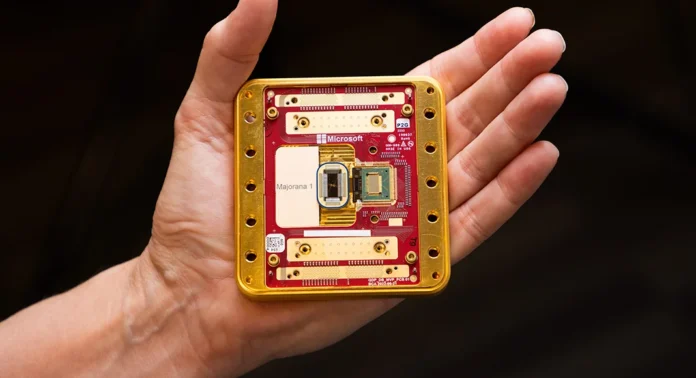Quantum computing has long promised to reshape the boundaries of technology, but practical and stable systems have remained elusive. Microsoft’s introduction of Majorana 1, the first quantum processor built on topological qubits, signals a decisive shift toward making that promise a reality. Unlike earlier approaches, Majorana 1 is designed with a foundation that prioritizes stability and scalability—two pillars that have historically hampered quantum progress. With this launch, Microsoft positions itself not just as a competitor in the quantum race, but as a potential leader in redefining what the technology can achieve.
The significance of Majorana 1 lies in its architecture. Instead of relying on fragile qubits that demand constant correction, Microsoft leverages topological qubits, which are inherently more resistant to external noise and computational errors. This could dramatically reduce the resources required to maintain system reliability, making large-scale quantum computing more feasible than previously imagined. In essence, the company is not merely iterating on existing methods; it is attempting to build the “transistor of the quantum age.”
This breakthrough arrives at a moment of heightened urgency. Global industries, from pharmaceuticals to energy, are increasingly looking to quantum computing to solve problems that classical machines cannot. Climate simulations, drug discovery, materials engineering, and cryptography all represent domains where the stakes are high and the solutions are beyond current computational limits. Majorana 1, therefore, is not just a technical milestone—it is a potential turning point in how societies will address the world’s most complex challenges.
For Microsoft, the unveiling of Majorana 1 also marks a strategic move in the broader quantum race, where rivals like Google and IBM have taken different routes. While others focus on brute-force expansion of qubit numbers, Microsoft’s bet on qubit stability over scale could prove to be the key differentiator. Backed by DARPA through the US2QC initiative, this approach could accelerate not only research timelines but also the path to commercialization.
Why Majorana 1 Matters
At the core of Majorana 1 is Topological Core Architecture, a design that enables qubits formed from exotic particles known as Majorana zero modes. Built with indium arsenide (a semiconductor) and aluminum (a superconductor), the chip creates conditions that allow these rare particles to be both detected and controlled. The result is a processor capable of producing qubits that are significantly less error-prone than traditional quantum units.
This resilience is transformative. Where conventional qubits require thousands of error-correcting counterparts to maintain accuracy, topological qubits may drastically reduce that overhead. In practice, Majorana 1 could run complex computations with fewer qubits while achieving higher stability—a leap forward in both efficiency and reliability.
Microsoft’s Chief Technical Fellow, Chetan Nayak, described the ambition as creating “the transistor for the quantum era.” In other words, Majorana 1 is not just another chip; it is an attempt to establish the fundamental building block upon which future quantum systems will be built.
Potential Beyond Classical Limits
The applications of Majorana 1 stretch far beyond theoretical physics. With its enhanced stability, the processor could enable breakthroughs in fields long constrained by the limits of classical computing:
- Pharmaceutical research: simulating molecules to accelerate drug discovery.
- Materials science: developing self-healing and ultra-light materials.
- Environmental science: breaking down microplastics or modeling climate systems with unprecedented detail.
- Agriculture and health: optimizing enzymes to improve crop yields and treatments.
These are not distant hypotheticals. Early demonstrations suggest that such quantum-enabled research could arrive within this decade, shifting innovation cycles across industries.
Scalability and Industrial Promise
One of the greatest challenges in quantum computing is scaling qubits without losing coherence. Traditional systems collapse as more qubits are added, leading to instability and errors. Majorana 1 offers a different trajectory. According to Microsoft, the architecture could scale to one million qubits on a single chip, unlocking computational capacity at levels no classical system could ever match.
This capacity is not just about speed; it is about solving classes of problems that classical computers fundamentally cannot. From secure cryptography to training next-generation AI models, Majorana 1 could redefine digital infrastructure at a systemic level.
Backed by DARPA’s Strategic Vision
Microsoft’s progress with Majorana 1 is bolstered by its partnership with the Defense Advanced Research Projects Agency (DARPA). Through the US2QC program, DARPA aims to push forward utility-scale quantum computing, focusing on approaches resilient enough to move beyond academic labs and into real-world deployment. With DARPA’s history of funding paradigm-shifting technologies such as the internet and AI, this collaboration underscores the seriousness of the effort.
Access to DARPA’s funding and expertise accelerates Microsoft’s trajectory toward commercialization. If successful, Majorana 1 could be among the first quantum processors ready for both industrial applications and advanced scientific research—bringing the technology out of theory and into practice.
What Comes Next
The unveiling of Majorana 1 is more than a corporate milestone; it may represent the dawn of a new computational era. Microsoft’s approach, built on the stability of topological qubits, introduces a viable path toward solving problems that have long remained out of reach. While challenges remain—including scaling production, integrating software frameworks, and building quantum-classical hybrid systems—the momentum is undeniable.
If the predictions hold true, the coming years could see quantum computing move from abstract promise to tangible impact, transforming industries from healthcare to cybersecurity. Majorana 1, therefore, should not be seen as a finished product, but as the first solid foundation for a future in which quantum power becomes a mainstream tool for science, industry, and society.

